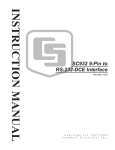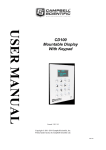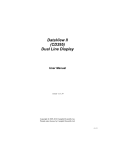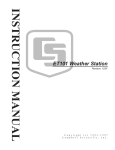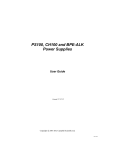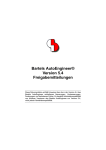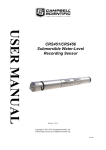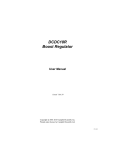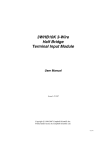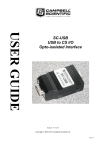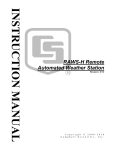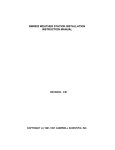Download Campbell SC105 CS User guide
Transcript
SC105 9-Pin to RS-232-DCE Interface User Guide Issued 19.10.10 Copyright © 2004-2010 Campbell Scientific Inc. Copied under licence by Campbell Scientific Ltd. CSL 36 Guarantee This equipment is guaranteed against defects in materials and workmanship. This guarantee applies for twelve months from date of delivery. We will repair or replace products which prove to be defective during the guarantee period provided they are returned to us prepaid. The guarantee will not apply to: • Equipment which has been modified or altered in any way without the written permission of Campbell Scientific • Batteries • Any product which has been subjected to misuse, neglect, acts of God or damage in transit. Campbell Scientific will return guaranteed equipment by surface carrier prepaid. Campbell Scientific will not reimburse the claimant for costs incurred in removing and/or reinstalling equipment. This guarantee and the Company’s obligation thereunder is in lieu of all other guarantees, expressed or implied, including those of suitability and fitness for a particular purpose. Campbell Scientific is not liable for consequential damage. Please inform us before returning equipment and obtain a Repair Reference Number whether the repair is under guarantee or not. Please state the faults as clearly as possible, and if the product is out of the guarantee period it should be accompanied by a purchase order. Quotations for repairs can be given on request. It is the policy of Campbell Scientific to protect the health of its employees and provide a safe working environment, in support of this policy a “Declaration of Hazardous Material and Decontamination” form will be issued for completion. When returning equipment, the Repair Reference Number must be clearly marked on the outside of the package. Complete the “Declaration of Hazardous Material and Decontamination” form and ensure a completed copy is returned with your goods. Please note your Repair may not be processed if you do not include a copy of this form and Campbell Scientific Ltd reserves the right to return goods at the customers’ expense. Note that goods sent air freight are subject to Customs clearance fees which Campbell Scientific will charge to customers. In many cases, these charges are greater than the cost of the repair. Campbell Scientific Ltd, Campbell Park, 80 Hathern Road, Shepshed, Loughborough, LE12 9GX, UK Tel: +44 (0) 1509 601141 Fax: +44 (0) 1509 601091 Email: [email protected] www.campbellsci.co.uk PLEASE READ FIRST About this manual Please note that this manual was originally produced by Campbell Scientific Inc. primarily for the North American market. Some spellings, weights and measures may reflect this origin. Some useful conversion factors: Area: 1 in2 (square inch) = 645 mm2 Length: 1 in. (inch) = 25.4 mm 1 ft (foot) = 304.8 mm 1 yard = 0.914 m 1 mile = 1.609 km Mass: 1 oz. (ounce) = 28.35 g 1 lb (pound weight) = 0.454 kg Pressure: 1 psi (lb/in2) = 68.95 mb Volume: 1 UK pint = 568.3 ml 1 UK gallon = 4.546 litres 1 US gallon = 3.785 litres In addition, while most of the information in the manual is correct for all countries, certain information is specific to the North American market and so may not be applicable to European users. Differences include the U.S standard external power supply details where some information (for example the AC transformer input voltage) will not be applicable for British/European use. Please note, however, that when a power supply adapter is ordered it will be suitable for use in your country. Reference to some radio transmitters, digital cell phones and aerials may also not be applicable according to your locality. Some brackets, shields and enclosure options, including wiring, are not sold as standard items in the European market; in some cases alternatives are offered. Details of the alternatives will be covered in separate manuals. Part numbers prefixed with a “#” symbol are special order parts for use with non-EU variants or for special installations. Please quote the full part number with the # when ordering. Recycling information At the end of this product’s life it should not be put in commercial or domestic refuse but sent for recycling. Any batteries contained within the product or used during the products life should be removed from the product and also be sent to an appropriate recycling facility. Campbell Scientific Ltd can advise on the recycling of the equipment and in some cases arrange collection and the correct disposal of it, although charges may apply for some items or territories. For further advice or support, please contact Campbell Scientific Ltd, or your local agent. Campbell Scientific Ltd, Campbell Park, 80 Hathern Road, Shepshed, Loughborough, LE12 9GX, UK Tel: +44 (0) 1509 601141 Fax: +44 (0) 1509 601091 Email: [email protected] www.campbellsci.co.uk Contents PDF viewers note: These page numbers refer to the printed version of this document. Use the Adobe Acrobat® bookmarks tab for links to specific sections. 1. General Description .................................................... 1 2. Specifications .............................................................. 2 3. Set-up Menu ................................................................. 3 3.1 Set-up Menu Selections ............................................................................ 4 4. Installation.................................................................... 5 5. RAD Modem Application ............................................. 5 5.1 RAD Modem - Two Way ......................................................................... 6 5.2 RAD Modem Wiring and Grounding ....................................................... 6 5.3 Testing RAD Modem Communication ..................................................... 8 6. CDMA Modem Application .......................................... 9 7. Freewave Radio Application ....................................... 9 Figures 1. 2. 3. 4. SC105 9-Pin to RS-232-DCE Interface ...................................................... 1 Set-up Menu ............................................................................................... 4 Two Way Communication .......................................................................... 6 Installation of Spark Gap Protection........................................................... 7 Table 1. Approximate Range, miles and km............................................................. 6 i SC105 9-Pin to RS-232-DCE Interface Figure 1. SC105 9-Pin to RS-232-DCE Interface 1. General Description The SC105 (Figure 1) is used to interface a CSI datalogger to any modem that is configured with an RS-232 DCE (Data Communications Equipment) serial port. The SC105 is an intelligent interface that buffers data (1k buffer size), allowing many RS-232 data rates, and all CS I/O port modes. Features include: • True RS-232 signal levels. • Power for the SC105 is supplied from the 5 V supply on pin 1 of the datalogger’s I/O port. The SC105 will use the 5 V supply to power the RS-232 modem if needed. • Two way (interactive) communication. • Supports most RS-232 baud rates. • Supports all CS I/O port modes. The SC105 is frequently used with a short haul modem to communicate across a dedicated line made of two pairs of twisted wire with a shield. Section 3 describes the details of this application using a short haul modem built by RAD. The SC105 is also commonly used with satellite transmitters, cellular modems, and spread spectrum radios. The SC105 also supports one way output or printer communication. 1 SC105 9-Pin to RS-232-DCE Interface 2. Specifications RS-232 9-Pin Female Connector Pin-out: Pin No. 1 2 3 4 5 6 7 8 9 I/O In In Out Out In Out In In Name DCD RXD TXD DTR GND DSR RTS CTS Ring Description Data Carrier Detect (No Connection) Received Data Transmitted Data Data Terminal Ready Signal Ground Data Set Ready (No Connection) Request to Send – Modem Enable Clear to Send Rings Datalogger CS I/O 9-Pin Male Connector Pin-out: 2 Pin No. I/O Name Description 1 2 3 4 5 6 7 8 9 +5V GND RING RXD ME SDE CLK/HS +12V TXD Regulated 5 Volt supply Ground Ring signal to datalogger SC105 transmits on this line Modem Enable—must be high for transfer in ME mode Synchronous Device Enable Clock/Handshake (for synchronous communication) Not Used SC105 receives on this line in out out in in In in User Guide RS-232 Baud Rates The SC105 will support the following baud rates: 1200, 9600, 19200, 38400, 57600, 115200 RS-232 Parity and Data The SC105 supports the following: Parity: Even, Odd, None Data Bits: 7, 8 CS I/O Port Modes: CSDC, SDC, ME, Addressed Print Device for P96 output Electrical The SC105 uses power from the +5 V line on the 9-pin interface connected to the datalogger. Current Standby: 0.16 mA Communicating: 1 to 4 mA Additional current (up to 8 mA) from the 5 V supply may be used by the RS-232 device connected to the SC105. Physical Height: Width: Length: Weight: 0.9 in (2.3 cm) 1.6 in (4.1 cm) 3.5 in (8.9 cm) 1.6 oz (45.4 g) Environmental Temperature: Humidity: -25o to +50oC up to 95% non-condensing 3. Set-up Menu The SC105 has a built-in Set-up Menu for configuring communication mode, CS I/O port configuration, RS-232 port configuration, and other parameters. The Set-up Menu is shown in Figure 2. It is accessed by connecting the SC105’s RS-232 port to a PC with the included null modem cable. The SC105 also needs to have power. Usually the SC105 is powered by connecting the SC105’s CS I/O port to the CS I/O port of a datalogger. With the null modem connection to the PC, typically Campbell Scientific’s Device Configuration (DevConfig) Utility is used, but a terminal program such as HyperTerminalTM or ProcommTM (always 9600 baud, 8-N-1) can also be used. Press the “Program” button on the SC105 for one second to access the Set-up Menu. Changed settings are saved in flash memory by selecting Apply in DevConfig or menu item “4” if using HyperTerminal or Procomm. If left idle, the Set-up Menu will time out 60 seconds after the last received character and exit without saving any parameter changes with the message “Set-up Timeout.” A datalogger can remain connected to the CS I/O port (to provide power to 3 SC105 9-Pin to RS-232-DCE Interface SC105) while setting SC105 parameters on the RS-232 port, although CS I/O communications would be inactive until exiting the Set-up Menu. SC105 - SW Version 2.0 Main Menu: Current Configuration (1) CS I/O Port Configuration [Modem Enable] (2) RS-232 Port Configuration [9600] (3) Restore Factory Defaults (4) Save and Exit (5) Exit w/o Saving Settings (9) Help Enter Choice: Figure 2. Set-up Menu 3.1 Set-up Menu Selections 1) CS I/O Port Configuration An SC105 may be activated either by the Modem Enable signal or by a Synchronous Device (SDC) address (7, 8, or 9). If PakBus Networking is being used, SDC address 7 or 8 should be selected. Addressed Print Device is a mode that allows output from the datalogger when it executes the P96 instruction. 2) RS-232 Port Configuration RS-232 baud rate, data bits, and parity are configured here, as well as the RS-232 Auto Power Down (APD) Mode. The APD mode should be left enabled, unless the attached RS-232 device requires power from the RS-232 lines. The DTR and RTS Mode setting allows control over how these two lines behave. DTR is on pin 4 of the RS-232 connector; RTS is on pin 7. 4 User Guide 'PC/PDA mode': DTR and RTS are both driven to 5 V. 'Modem mode': DTR will be driven to +5 V when the CS I/O interface is active for Modem Enable, SDC Address 9, and Addressed Print Device configurations. When the CS I/O is inactive, DTR will be 0 V. Additionally, there will be a 'dead time' after DTR is dropped of 2 sec when data coming in on the RS-232 will be ignored. For SDC Address 7 or 8, DTR will always be driven to +5 V. RTS will 'key' the data; it will be driven (+5 V) 20 msec prior to data being sent out the RS-232, and remain driven for 5 seconds after the last data is sent out the RS232. 'Custom mode': This mode is identical to the 'Modem mode', except the delays between RTS HI and data, data and RTS LO, and the 'dead time' are all configurable. 4. Installation Connect the SC105 to the RS-232 device and to the datalogger with the SC12 9pin cable (included). If the device has a 25-pin connector, a 9-pin female to 25pin male adapter is required (CSI PN #15751). Proper transient protection should be installed to protect the computer and datalogger in areas where damage due to lightning is possible. If this is a RAD modem application, see Section 5.2. 5. RAD Modem Application The SC105 is frequently used with a short-range modem to communicate across a 4-wire, unconditioned dedicated line. Campbell Scientific offers a kit (PN TBD) that includes the SC105, the 9- to 25-pin adapter (PN #15751), and a mounting bracket (PN #6282). The bracket will mount the RAD, SC105, and adapter to the back plate in a Campbell Scientific enclosure. This section describes using a short-range asynchronous modem built by RAD*. * SRM - 5A RAD Modem RAD Data Communications, Inc. 900 Corporate Drive Mahwah, NJ 07430 Tel: (201) 529-1100 Fax: (201) 529-5777 Email: [email protected] http://www.rad.com 5 SC105 9-Pin to RS-232-DCE Interface For transmission, the RAD modem uses a cable made of two pairs of twisted wires with a shield. Data rates up to 9600 bps are possible. The low voltage transmission levels minimize cross talk between adjacent lines within the same cable. Data are transmitted and received at a balanced impedance, providing excellent immunity to circuit noise. Table 1 gives the data rate possible for several gage cables across several distances. Table 1. Approximate Range, miles and km Data Rate Bps 19 Gauge (0.9 mm) 24 Gauge (0.5 mm) 26 Gauge (0.4 mm) miles km Miles km miles km 9,600 1,200 6.2 7.6 10.0 12.2 2.8 3.4 4.5 5.5 2.0 2.5 3.3 4.0 5.1 RAD Modem - Two Way PC SRM 4-WIRE UNCONDITIONED TELEPHONE LINE OR TWO TWISTED PAIRS SRM 9 TO 25 PIN ADAPTOR SC105 DATALOGGER Figure 3. Two Way Communication When using Campbell Scientific’s datalogger support software to communicate through the SC105/RAD modem, “Set-up” the link as a direct connect between the datalogger and the desired COM port. Start two way communication using the “Connect” button on the tool bar and the “Connect” button in the “Connect” window. 5.2 RAD Modem Wiring and Grounding Figure 4 shows a typical set-up of the RAD modems. Installation is as follows: 1. Set the DCE/DTE switch on the back of the RAD modem connected to the SC105 to DCE. For a RAD modem connected to a PC, set the DCE/DTE switch to DCE. For a RAD modem connected to a serial printer, set the DCE/DTE switch to DTE. 2. Select a cable with two or more twisted pairs. A recommended direct burial rodent resistant cable is listed below. They also sell several gopher resistant cables for even greater protection. Company Part Number Anixter F-02P22BPN Tel: 847-677-2600 http://www.anixter.com 6 AWG. 22 3. Wiring connections are made as shown in Figure 4. Note wires labelled A and B are one twisted pair of the cable. Wires labelled C and D are the other twisted pair. 4. Transients induced on the communication line may damage any electronics connected at either end of the line. To decrease the chances for damage, spark gaps should be installed as shown in Figure 4. The transient protection shown may be purchased from Campbell Scientific, Inc. (p.n. #5563 shown in Figure 4, p.n. #6536 includes a plastic case, p.n. #6361 User Guide includes hardware for mounting to ground lug of CSI enclosures models ENC 10/12, ENC 12/14, or ENC 16/18). Spark gap wiring is straight through such that pin to pin continuity exists between the two modems. If the modems are installed entirely within a building, the transient spark gap protection is probably not needed. Figure 4. Installation of Spark Gap Protection Occasionally a customer needs to transmit data across longer or smaller gage wires or at higher speeds than can be done with the RAD modem powered by the SC105. RAD does sell a 9-volt power supply that will boost the signals enough to meet some of these more demanding applications. Please contact RAD for more information. 7 SC105 9-Pin to RS-232-DCE Interface 5.3 Testing RAD Modem Communication The modem communication link is divided into the following three sections: 1) RAD modem computer end, 2) cable from computer modem to datalogger modem, 3) RAD modem datalogger end. When unable to establish communication with the datalogger, test each of the three sections. Before proceeding through the testing procedures, a terminal emulator software program such as HyperTerminalTM or Campbell Scientific’s datalogger support software (Test Terminal Emulator) must be used to communicate through the COM port of the computer. Once the emulator program is set up, testing can proceed as follows: 1. Disconnect the four conductor cables from the SRM-6A RAD modem at the computer end. Jumper the XMT + to RCV + and jumper the XMT - to RCV -. This creates a transmit loop which allows any key pressed at the computer keyboard to be seen on the screen. If the key pressed is not seen, check the following: COM port configuration, 25-pin cable from the computer to the modem and the RAD modem. 2. Reconnect the four conductor cables to the modem at the computer end and disconnect the cable from the modem at the datalogger end. Twist together the XMT + wire and RCV + wire, twist together the XMT - wire and the RCV - wire. Repeat the process of step 1 by pressing a key on the computer keyboard. If the key pressed is not returned, then the cable from the modem at the computer to the datalogger modem is defective and will need to be repaired or replaced. 3. If steps 1 and 2 pass, the modem at the datalogger is suspect. Disconnect the modem from the SC105 and bring the modem to the computer site. Attach the modem to the computer, and repeat step 1 by jumpering the terminals of the modem and pressing a key on the computer keyboard. If the above tests pass and communication to the datalogger still has not been established, perform tests 4, 5, and 6. 4. A 12 V lead acid battery supply should not be discharged below 11.76 V. If this occurs, the batteries will go into a deep discharge state and will need to be replaced. The CR10 will function properly on a battery voltage of 10 to 15 volts. Check the 12 V supply with a voltmeter. 5. On the wiring panel of most Campbell Scientific dataloggers there is a terminal marked 5 V. Check the 5 V supply with a voltmeter. This 5 V supply should be within a tenth of a volt. If not, it would indicate a problem. 6. To verify that the datalogger and its serial I/O port are working, try to access input memory locations using a laptop PC with the SC105 (using a null modem cable connection). Configure the SC105 CS I/O Port to Modem Enable for this test. 7. If test 6 fails, use a CR10KD Keyboard Display to access input locations. If the datalogger passes tests 4, 5, and 7, but fails test 6, then the SC105 is suspect and will need to be repaired or replaced. 8 User Guide 6. CDMA Modem Application In most modem applications the SC105 can be used with the factory defaults. This sets the SC105 up as modem enable 9600 baud, 8 data bits, Parity None and 1 stop bit. It also sets the DTR dead time to 2 seconds. This dead time is used to prevent characters produce by the modem from waking the datalogger up right after communications has been terminated. The dead time can be adjusted by changing the RS-232 DTR and RTS mode to Custom. The CS I/O port configuration has several other modes that can be used depending on the operating system used in the datalogger. These other modes offer advantages for some applications. When using the PakBus OS, SDC7 or SDC8 can be used. This allows communications from multiple sources at the same time (for example, CDMA modem, RF400, and CR10KD). Valid modes by Operating System: Modem Enable Standard OS (Array) X Table Data OS X PakBus OS X SDC 7, SDC 8 SDC 9 X X 7. Freewave Radio Application Typically, the Freewave Radios will be used in a PakBus network, with PakBus OS dataloggers. With a PakBus datalogger, the CS I/O port configuration on the SC105 should be set to SDC 7 or SDC 8. The RS-232 baud rate should be set to match the baud rate on the Freewave radios (38.4 k or 115 k are good choices). If the low power modes of the Freewave radios are to be used, the SC105 DTR and RTS mode setting will need to be configured to compensate for the turn-on latency of the Freewave radio. The radio uses the RTS signal to go in and out of its low power mode. The radio requires a delay from the time that it is brought out of the low power mode and the time it receives data over the RS-232 port. To do this, the default DTR and RTS mode will have to be changed to Custom with RTS High = 100, and RTS Low = 20. This gives 100 msec between RTS HI and data on the RS-232 port, and 2 seconds between data on the RS-232 port and RTS going LO. For a detailed Application Note on using Freewave Radios, see PakBus Networking with Freewave Radios. This application note gives complete details on the set-up of the datalogger, the SC105, the Freewave radio, and LoggerNet PC software for this application. 9 CAMPBELL SCIENTIFIC COMPANIES Campbell Scientific, Inc. (CSI) 815 West 1800 North Logan, Utah 84321 UNITED STATES www.campbellsci.com • [email protected] Campbell Scientific Africa Pty. Ltd. (CSAf) PO Box 2450 Somerset West 7129 SOUTH AFRICA www.csafrica.co.za • [email protected] Campbell Scientific Australia Pty. Ltd. (CSA) PO Box 444 Thuringowa Central QLD 4812 AUSTRALIA www.campbellsci.com.au • [email protected] Campbell Scientific do Brazil Ltda. (CSB) Rua Luisa Crapsi Orsi, 15 Butantã CEP: 005543-000 São Paulo SP BRAZIL www.campbellsci.com.br • [email protected] Campbell Scientific Canada Corp. (CSC) 11564 - 149th Street NW Edmonton, Alberta T5M 1W7 CANADA www.campbellsci.ca • [email protected] Campbell Scientific Centro Caribe S.A. (CSCC) 300N Cementerio, Edificio Breller Santo Domingo, Heredia 40305 COSTA RICA www.campbellsci.cc • [email protected] Campbell Scientific Ltd. (CSL) Campbell Park 80 Hathern Road Shepshed, Loughborough LE12 9GX UNITED KINGDOM www.campbellsci.co.uk • [email protected] Campbell Scientific Ltd. (France) Miniparc du Verger - Bat. H 1, rue de Terre Neuve - Les Ulis 91967 COURTABOEUF CEDEX FRANCE www.campbellsci.fr • [email protected] Campbell Scientific Spain, S. L. Avda. Pompeu Fabra 7-9 Local 1 - 08024 BARCELONA SPAIN www.campbellsci.es • [email protected] Campbell Scientific Ltd. (Germany) Fahrenheitstrasse13, D-28359 Bremen GERMANY www.campbellsci.de • [email protected] Please visit www.campbellsci.com to obtain contact information for your local US or International representative.


















